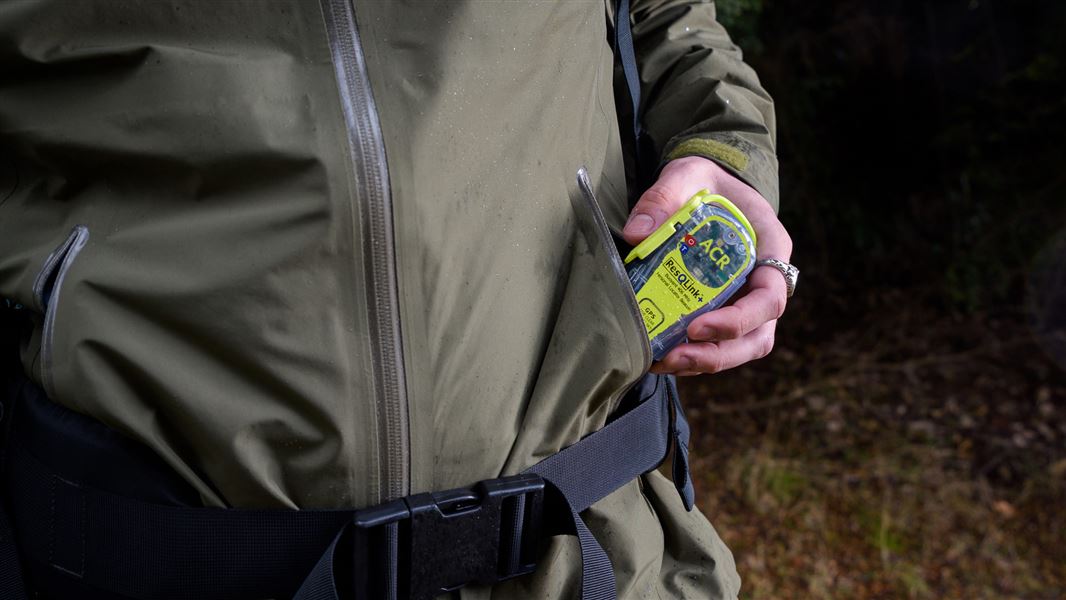A distress beacon is a small, lightweight device. You raise the aerial, push a button and it transmits a signal via satellites to tell rescuers you need assistance.
In New Zealand, the Rescue Coordination Centre NZ responds to all beacon activations. They work quickly to find out as many details as they can about who set off the beacon and promptly send search and rescue teams to assist.
Why you should take one
A distress beacon lets you instantly signal for help and they work almost anywhere in the world.
The beacon shows rescuers your approximate location, taking the ‘search’ out of search and rescue. The sooner rescuers can help you, the more likely you are to survive.
Call for help early
If you or someone else is in a life-threatening situation, set your beacon off. Situations can deteriorate rapidly. The sooner you activate it, the faster help can be sent to your location.
If you are unsure about when to activate the beacon, it is better to activate it and get help.
Types of beacon
Types of beacon include:
- PLB – Personal Locator Beacon designed to be carried by an individual person.
- EPIRB – Emergency Position Indicating Radio Beacon for use in boats and commercial vessels
- ELT – Emergency Locator Transmitter for use in aircraft
- SEND – Satellite Emergency Notification Device that allows users to send and receive messages, eg Garmin inReach, SPOT tracker.
See Rescue Coordination Centre NZ - beacons.org.nz for more information about beacons.
For most people doing outdoor activities, a PLB and/or a SEND are the right type of beacons to carry.
Difference between a PLB and SEND
Knowing the difference between a PLB and SEND (eg Garmin inReach, SPOT tracker) is important as it could impact on your safety and ability to get rescued.
PLB
PLBs are on a satellite network with good coverage across New Zealand. Batteries on some models last up to 10 years. The frequency they give out is powerful and able to get through foliage and clouds but it isn’t perfect, often a line of sight to the sky is still needed.
Some models come with both radio and satellite frequency (models with 406 Mhz and 121.5 Mhz capability) which means that when a rescue helicopter gets close, they can tune into the radio network and hone in on the PLB’s location. Newer models should also be GPS-enabled which will send your location to the rescue team.
SPOT tracker and Garmin inReach
SPOT and inReach use different satellite networks to PLBs. SPOT operates on the Globalstar satellite network and the inReach on the Iridium satellite network. They have the advantage of being able to live track you, but they rely on batteries that need charging, like you would a phone.
They use a different network to PLBs and have less coverage and a weaker signal. They might not work if you are under thick canopy, in a particularly remote location, or the weather is bad.
The inReach and some SPOT models are able to send pre-set messages or two-way communication like a phone.
The messages and emergency alerts from SPOT and inReach go through a third-party desk overseas which are then forwarded to the New Zealand Rescue Coordination Centre.
Carrying two devices
You may choose to carry a SEND and a PLB. This gives you the advantage of the two-way communication network on the SEND to update trip intentions, get weather forecasts, allow family and friends to track your movements, and give details when needing a rescue. As well as a PLB as a safer, reliable option to activate in emergencies – without the worry about signal strength or batteries dying.
Buy a beacon
Distress beacons are widely used in New Zealand with over 100,000 in circulation.
Beacons cost between $300–$500, a small price to pay to save your life.
Owning a SEND
Many SEND require an ongoing, paid subscription to send or receive any messages, whether or not it is an emergency.
Owning a PLB
All PLBs must be registered. Registering your PLB is fast, easy and free. It’s also required by law. Registration provides searchers with essential information that could save your life. Once registered there are no ongoing subscription fees.
Hire a beacon
Hiring is an affordable option if you don’t want to buy. There are hire outlets throughout New Zealand.
You can hire PLBs at these DOC Visitor Centres.
North Island:
- Kauaeranga Visitor Centre
- Tongariro National Park Visitor Centre
- Taranaki/ Egmont National Park Visitor Centre
South Island:
- Rotoiti / Nelson Lakes Visitor Centre
- Aoraki / Mount Cook National Park Visitor Centre
- Arthur’s Pass National Park Visitor Centre
- Paparoa National Park Visitor Centre
- Tititea / Mount Aspiring National Park Visitor Centre
- Whakatipu-wai-Māori / Queenstown Visitor Centre
- Westland Tai Poutini National Park Visitor Centre
Stewart Island:
- Rakiura National Park Visitor Centre
You can also hire beacons at other places, such as tramping shops. Find a hire place near you.
Beacon disposal
Old or obsolete beacons need to be disposed of carefully to ensure that they do not get activated accidentally. Return your beacon to:
- the retailer where you purchased it
- your nearest police station, or
- Rescue Coordination Centre NZ by courier.
